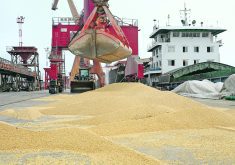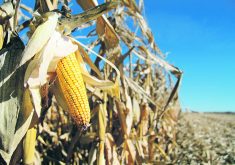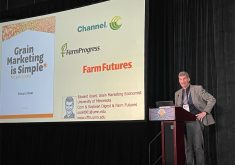SAN ANTONIO, Texas — Ed Usset says now is a good time to be contracting some of the 2017-18 soybean crop.
The grain marketing economist with the Center for Farm Financial Management at the University of Minnesota has created simple one-page pre-harvest marketing plans for soybeans, corn and spring wheat.
He created the plans six months ago, which consist of minimum prices and decision dates.
By setting down specific dates for pricing decisions, the system forces farmers to regularly assess the market’s position relative to his costs of production during the period when it often rallies to “buy acres.”
Read Also

Why feds imposed EV tariffs
Moe and Kinew have a fight on their hands when it comes to eliminating the EV tariff. Canada has to worry about pissing off the U.S. and Mexico and hundreds of thousands of auto workers.
Otherwise, marketing might take a back seat to the demands of seeding time.
The first decision date for soybeans is April 11, and the minimum price a farmer should consider selling his beans at before that date is a November futures price of US$10.25 per bushel.
Usset arrived at that number by calculating the cost of production for growing soybeans in southwestern Minnesota. The cost of production includes a modest return for family living.
“I’m not interested in pricing below that,” he told delegates attending the 2017 Commodity Classic in San Antonio.
The November futures contract closed at $10.33 the night before he gave his presentation.
“You’ve got an opportunity today in soybeans,” Usset told the farmers taking in his presentation.
The $10.25 minimum price is the starting point for the marketing plan. The next decision date is May 10 and the minimum price for that period is $11 per bu. The last decision date is June 9 with an $11.75 minimum.
“Decision dates make it a real plan for action,” he said.
The objective is for the farmer to price 75 percent of his anticipated soybean crop by mid-June.
“Spring is traditionally the best time to get something done. There is a strong tendency for markets to be a little high in the spring.”
Usset said there have been price rallies in each of the last three springs. He also determined a “realistic” maximum price of $12.50 for soybeans.
“Now you’ve got the bookends to put your price objectives in between,” he said.
A farmer who expects to produce 25,000 bu. of soybeans would price 5,000 bu. on the first, third and fourth decision dates and 2,500 bu. on the second.
Most of his presentation focused on the soybean marketing plan, but he briefly touched on corn and wheat.
His corn plan starts with a minimum December futures price of $4.50 per bu. and works up to $6 by the June 9 decision date.
The spring wheat plan starts with a minimum September futures price of $6 per bu. and rises to $8 per bu. by June 9.
That’s where things get tricky. His minimum corn futures price is 50 cents per bu. higher than today’s value and his spring wheat trigger is 40 cents higher.
Usset said he would still get something done this spring on wheat and corn, pricing 20 to 40 percent of anticipated production.
“Why on Earth would I sell corn (50 cents per bu.) below production costs? Because that’s better than $1 below production costs at harvest.”
Usset acknowledged it is an imperfect plan, but it is better than having no marketing plan at all.
He encouraged farmers to use simple, low-cost marketing tools early in their marketing plan, such as forward contracts and futures contracts.
Later in the plan, if there is a bull market, they can get creative and use put options to establish a minimum price and capture some of the upside as well.
Usset said farmers shouldn’t get upset if they lock in soybeans at $10.25 per bu. and then the price increases to $11 or $12.
“Just get it priced and then hope to heck you’re wrong,” he said.
“You’re a producer. You always want prices to go higher.”
His plans can be found on the university’s website at www.cffm.umn.edu/grainmarketing/marketingplans.aspx.
















